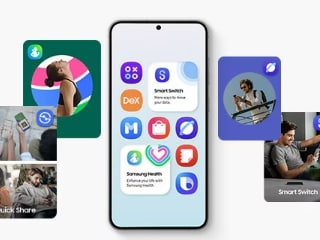- Home
- Mobiles
- Mobiles News
- Samsung Continues to Lead Smartphone Market Despite Fall in Shipments in Q1: Canalys
Samsung Continues to Lead Smartphone Market Despite Fall in Shipments in Q1: Canalys
Samsung saw a two percent increment in its market share from last year, while Apple grew its share by three percent, according to Canalys.

Photo Credit: Samsung
Samsung Galaxy S22 series helped the company grow its market
Samsung has continued to lead the smartphone market despite a fall of 11 percent year-on-year in the worldwide shipments in the first quarter of 2022, according to a report. The South Korean company introduced its Galaxy S22 series in the quarter that has apparently helped grow its market share. After Samsung, Apple retained its second position in the global market. Both Samsung and Apple expanded their market share in the quarter. However, top-three Chinese players — Xiaomi, Oppo, and Vivo — saw declines in their shares.
Market research firm Canalys said in its report that worldwide smartphone shipments dropped 11 percent year-on-year in the midst of unfavourable economic conditions due to the COVID-19 pandemic and sluggish seasonal demand in the first quarter.
However, the dip did not result in an adverse environment for Samsung as the company managed to grow its share to 24 percent in the first quarter of 2022 from 22 percent in the same quarter of 2021, Canalys said. The company's share also increased by five percent from the fourth quarter of 2021 when it was at 19 percent. It introduced models including the Galaxy S22, Galaxy S22+, and Galaxy S22 Ultra in the quarter. Particularly, the Galaxy S22 Ultra replaced the Galaxy Note series by offering an integrated S Pen stylus and a top-notch combination of hardware and software.
Samsung was not the only vendor in the race to see growth despite the overall decline in shipments. Apple also increased its market share to 18 percent in the first quarter from 15 percent in the same quarter last year, according to Canalys.
The Cupertino company saw a growing demand for its iPhone 13 series in the quarter, the firm said.
"While the iPhone 13 series continues to capture consumer demand, the new iPhone SE (2022) launched in March is becoming an important mid-range volume driver for Apple," said Canalys Analyst Sanyam Chaurasia. "At a similar price point to its predecessor, it offers an upgraded chipset and improved battery performance and adds the 5G connectivity that operator channels are demanding."
Unlike Samsung and Apple, Chinese smartphone makers in the top-five list of vendors globally were not able to grow their market in the first quarter. Canalys' report shows that Xiaomi, Oppo, and Vivo, instead, saw dips in their shares.
Xiaomi continued to be in the third position, though its share in the market dropped to 13 percent in the first quarter of 2022 from 14 percent in the same quarter of 2021. Similarly, Oppo came fourth, with its share declining to 10 percent from 11 percent in the same quarter last year. Oppo's performance included the shipments of OnePlus phones in the market worldwide.
Vivo — the sibling of Oppo and a subsidiary of China's BBK Electronics — also saw a dip of two percent in its share from 10 percent in the first quarter of 2021 to eight percent in the last quarter, as per the data shared by Canalys.
Smartphone vendors' worldwide market share
| Vendor | Q1 2021 market share | Q1 2022 market share |
|---|---|---|
| Samsung | 22 percent | 24 percent |
| Apple | 15 percent | 18 percent |
| Xiaomi | 14 percent | 13 percent |
| Oppo | 11 percent | 10 percent |
| Vivo | 10 percent | 8 percent |
| Others | 28 percent | 27 percent |
"While Chinese vendors are still suffering supply constraints at the low end, their global expansion is being hampered by a slowdown in their home market," said Chaurasia.
The ongoing Russia-Ukraine conflict, China's fresh lockdowns, and the threat of inflation are amongst the few major hurdles for smartphone manufacturers around the globe. Consumer demand across the worldwide market is also not favourable to bring any significant growth.
"Vendors must equip themselves to respond quickly to emerging opportunities and risks while staying focused on their long-term strategic plans," said Canalys VP Mobility Nicole Peng. "The good news is that the painful component shortages might improve sooner than expected, which will certainly help relieve cost pressures."
The new problems for smartphone vendors emerged just months after the market started to recover from the COVID-19 impact. It saw a seven percent year-on-year growth in shipments to 1.35 billion units in 2021, a previous report by Canalys showed.
That said, manufacturers are busy developing their new models to convince customers and make the market favourable for them in the coming months. Samsung, Google, and Xiaomi are amongst the companies working on their new premium and mid-range models that could start arriving as early as this quarter.
Catch the latest from the Consumer Electronics Show on Gadgets 360, at our CES 2026 hub.
Related Stories
- Samsung Galaxy Unpacked 2025
- ChatGPT
- Redmi Note 14 Pro+
- iPhone 16
- Apple Vision Pro
- Oneplus 12
- OnePlus Nord CE 3 Lite 5G
- iPhone 13
- Xiaomi 14 Pro
- Oppo Find N3
- Tecno Spark Go (2023)
- Realme V30
- Best Phones Under 25000
- Samsung Galaxy S24 Series
- Cryptocurrency
- iQoo 12
- Samsung Galaxy S24 Ultra
- Giottus
- Samsung Galaxy Z Flip 5
- Apple 'Scary Fast'
- Housefull 5
- GoPro Hero 12 Black Review
- Invincible Season 2
- JioGlass
- HD Ready TV
- Laptop Under 50000
- Smartwatch Under 10000
- Latest Mobile Phones
- Compare Phones
- Samsung Galaxy A07 5G
- Vivo Y500i
- OnePlus Turbo 6V
- OnePlus Turbo 6
- Itel Zeno 20 Max
- OPPO Reno 15 Pro Mini 5G
- Poco M8 Pro 5G
- Motorola Signature
- Lenovo Yoga Slim 7x (2025)
- Lenovo Yoga Slim 7a
- Realme Pad 3
- OPPO Pad Air 5
- Garmin Quatix 8 Pro
- NoiseFit Pro 6R
- Haier H5E Series
- Acerpure Nitro Z Series 100-inch QLED TV
- Asus ROG Ally
- Nintendo Switch Lite
- Haier 1.6 Ton 5 Star Inverter Split AC (HSU19G-MZAID5BN-INV)
- Haier 1.6 Ton 5 Star Inverter Split AC (HSU19G-MZAIM5BN-INV)

















